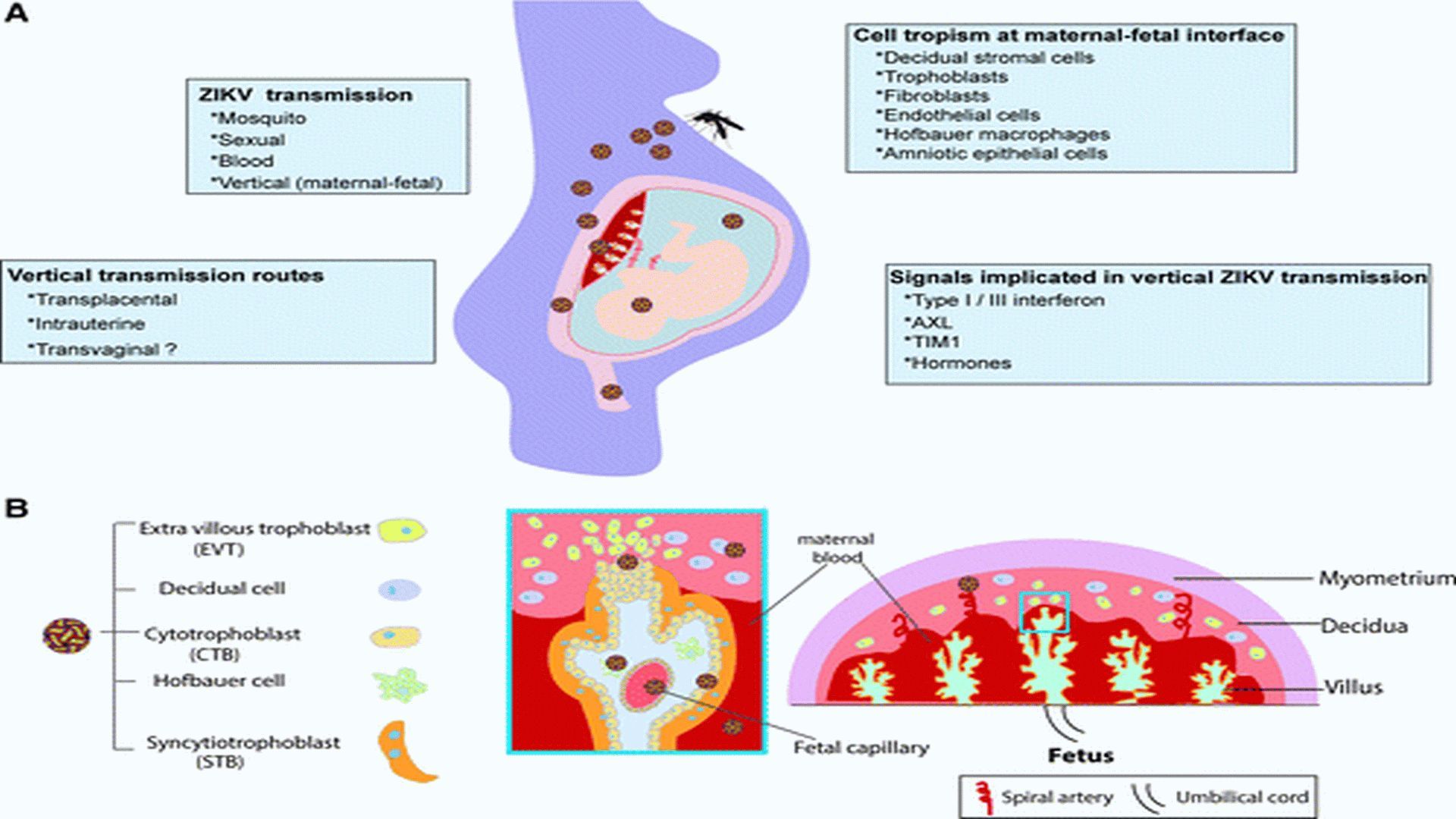Maternal-Fetal Transmission of Zika Virus and Therapeutic Approaches to Prevent It
The devastating effects of Zika virus on the brain of the developing fetus during infection in pregnancy have led to intensive research to understand the routes of Zika virus transmission and how the virus travels to and infects the fetus. What researchers have learned about how Zika virus impacts pregnancy and neonatal outcomes and the promise of new therapeutic interventions are presented in a comprehensive review article published in Journal of Interferon & Cytokine Research (JICR) from Mary Ann Liebert, Inc., publishers.


ZIKV infection pathogenesis in pregnancy. (A) Summary of routes of ZIKV transmission in a pregnant woman and the cells and signals implicated in transmission. (B) Structure of human placenta and sites of ZIKV infection. In the human placenta, there exist fetal-derived chorionic villi (blue box), which are tree-like projections lined with 2 layers of trophoblasts and bathed in maternal blood. Villous trophoblasts comprise 2 layers: the STBs and CTBs. The CTBs are highly proliferative and form a monolayer of polarized cells that eventually differentiate via cell–cell fusion into STBs. STBs form a surface covered by a dense network of branched microvilli that are bathed in maternal blood, mediate nutrient and gas exchange between mother and fetus. Fetal-derived macrophages, known as Hofbauer cells, are found in the intervillous spaces. A subset of trophoblasts, termed EVTs, migrates from the chorionic villi, invades into the uterine wall, and remodels maternal spiral arteries to facilitate blood supply of the placental unit. In addition to the EVTs, the decidual compartment also includes maternal immune cells (eg, decidual macrophages, decidual natural killer cells) and stromal cells. CTBs, cytotrophoblasts; EVTs, extravillous cytotrophoblasts; STBs, syncytiotrophoblasts; ZIKV, Zika virus. Courtesy of Mary Ann Liebert, Inc., publishers
The devastating effects of Zika virus on the brain of the developing fetus during infection in pregnancy have led to intensive research to understand the routes of Zika virus transmission and how the virus travels to and infects the fetus. What researchers have learned about how Zika virus impacts pregnancy and neonatal outcomes and the promise of new therapeutic interventions are presented in a comprehensive review article published in Journal of Interferon & Cytokine Research (JICR) from Mary Ann Liebert, Inc., publishers.
In the article titled "Maternal-Fetal Transmission of Zika Virus: Routes and Signals for Infection," co-authors Bin Cao, Michael Diamond, and Indira Mysorekar, Washington University School of Medicine, St. Louis, discuss Zika virus transmission in pregnancy -- whether a woman becomes infected from a mosquito or via sexual contact with an infected person -- how the virus reaches the intrauterine space and infects the fetus, and its negative effects on pregnancy outcomes that may include miscarriage, microcephaly and other serious brain abnormalities or birth defects in the neonate. The authors also present the latest research on the development of therapies aimed at blocking Zika virus transmission from mother to fetus.
"This is a very informative and timely article on Zika virus transmission, currently a major threat to public health," says Ganes C. Sen, Journal of Interferon & Cytokine Research co-editor-in-chief.
Research reported in this publication was supported by the National Institutes of Health under Award Numbers R01 AI073755, R01AI104972, and P01AI106695. The content is solely the responsibility of the authors and does not necessarily represent the official views of the National Institutes of Health.
Source: Mary Ann Liebert, Inc./Genetic Engineering News
Robust infectious disease surveillance, including rapid subtyping of influenza A, is essential for early detection, containment, and public health reporting of novel viral threats.